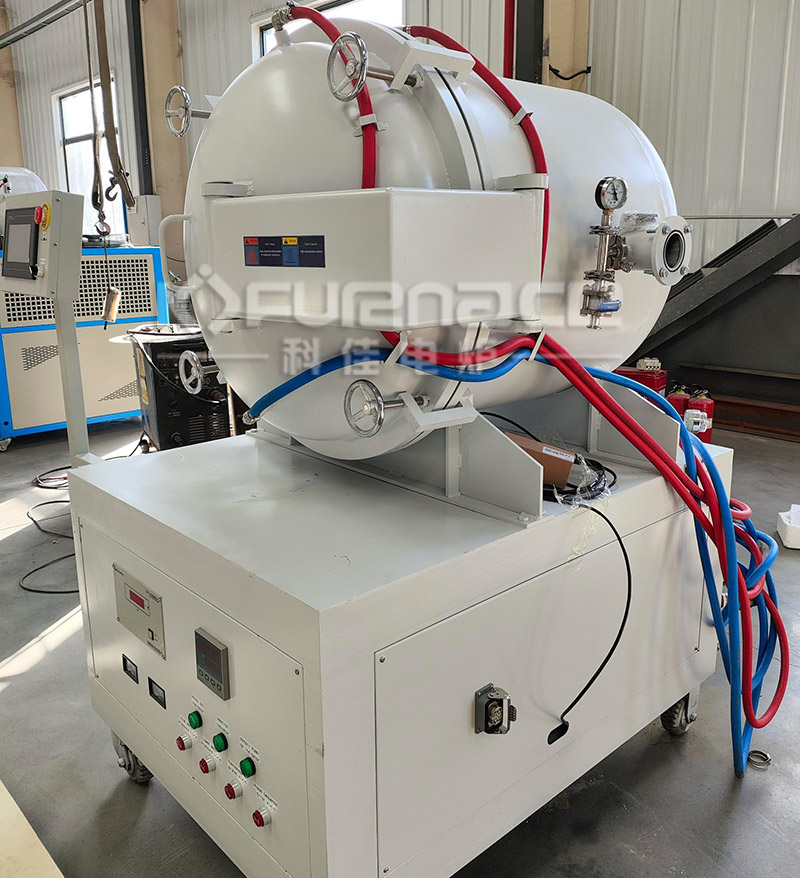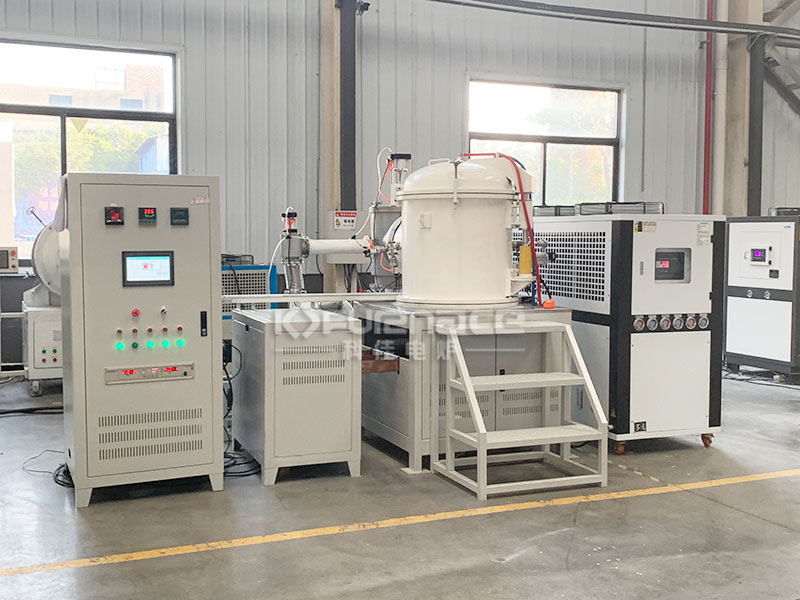The vacuum heat treatment electric furnace used in experiments can simulate material reactions under extreme conditions by precisely controlling the vacuum environment (pressure can be as low as 10 ⁻³ Pa to 10 ⁻⁴ Pa) and temperature (usually up to 1600 ℃ -2200 ℃), and is widely used in the preparation and modification of materials such as metals, ceramics, and semiconductors. Let’s take a detailed look at what experiments can be conducted on vacuum heat treatment electric furnaces!

Commonly used vacuum sintering furnaces (click on the image to view product details)
1 .Heat treatment of metal materials
annealing
Purpose: To eliminate internal stress in metals, improve tissue uniformity, and reduce hardness.
Typical experiment:
Vacuum annealing of high-speed steel cutting tools (500-650 ℃) to avoid oxidation and decarburization;
Titanium alloy vacuum annealing (700-900 ℃) eliminates work hardening and improves plasticity.
Advantages: No formation of oxide layer, high surface smoothness, and more stable material properties.
vacuum tempering
Purpose: To eliminate quenching stress and adjust the balance between hardness and toughness.
Typical experiment:
Vacuum tempering of bearing steel (150-200 ℃) reduces brittleness and extends service life;
Vacuum tempering of tool steel (500-600 ℃) to optimize cutting performance.
Advantages: Avoiding temper brittleness and achieving more uniform material properties.
2. Ceramic material sintering
Vacuum pressureless sintering
Objective: To prepare ceramic materials with high density and low porosity.
Typical experiment:
Aluminum oxide ceramics (Al ₂ O3) are vacuum sintered (1600-1700 ℃), resulting in a significant increase in relative density;
Silicon nitride ceramics (Si ∝ N ₄) vacuum sintering (1700-1800 ℃) improves bending strength.
Advantages: Avoiding the introduction of oxidative impurities and improving the mechanical properties of materials.
Hot pressing sintering
Purpose: To promote densification by applying external pressure.
Typical experiment:
Silicon carbide (SiC) vacuum hot pressing sintering (2000-2200 ℃) greatly improves mechanical hardness;
Zirconium boride (ZrB ₂) vacuum hot pressing sintering (1900-2000 ℃) improves high temperature resistance.
Key equipment: A hydraulic system is required, and pressure uniformity is crucial.
3. Preparation of Semiconductor Materials
crystal growth
Purpose: To prepare single crystal or polycrystalline semiconductor materials.
Typical experiment:
Silicon (Si) single crystal vacuum direct drawing method (Czochralski method, 1420 ℃), used for integrated circuit substrates;
Gallium arsenide (GaAs) vacuum vertical gradient solidification method (VGF method, 1238 ℃), used for high-frequency devices.
Key parameters: Temperature gradient control (≤ 10 ℃/cm) to avoid dislocation defects.
Thin film deposition
Purpose: To deposit functional thin films on the substrate surface.
Typical experiment:
Chemical Vapor Deposition (CVD): Vacuum deposition of silicon nitride (Si3N4) thin films (800-1000 ℃) for MEMS devices.
Advantages: High purity of the film, strong adhesion, and no impurity pollution.
4. Composite material synthesis
Metal ceramic composite materials
Purpose: To combine metal toughness with ceramic hardness.
Typical experiment:
Ti SiC vacuum hot pressing composite (1500-1600 ℃) for aerospace applications;
Aluminum based alumina (Al Al ₂ O ∝) vacuum stir casting (700-800 ℃) enhances wear resistance.
Key technology: Interface bonding strength control to avoid pore defects.
carbon-carbon composite material
Objective: To prepare lightweight, high-strength, and high-temperature resistant materials.
Typical experiment:
Carbon fiber reinforced carbon matrix (C/C) vacuum impregnation carbonization cycle (1000-2200 ℃), used for rocket nozzles;
Graphite fiber reinforced silicon carbide (C/SiC) vacuum reaction sintering (1600-1800 ℃), used for brake discs.
Advantages: Low density (1.7-2.0 g/cm ³), temperature resistance up to 2200 ℃.
5. Special Atmosphere Experiment
Vacuum+inert gas (Ar/N ₂)
Purpose: To prevent material oxidation while controlling the reaction atmosphere.
Typical experiment:
Copper based vacuum brazing (900-1000 ℃, Ar gas protection) improves joint strength.
Vacuum+reactive gas (H ₂/CO)
Purpose: To achieve a reduction reaction.
Typical experiment:
Powder metallurgy vacuum reduction (1000-1200 ℃, H ₂ atmosphere) is used to prepare high-purity metal powders.
Safety requirements: Hydrogen leak detection (sensitivity ≤ 1 ppm), explosion-proof design.
6. Preparation of nanomaterials
Vacuum thermal evaporation
Purpose: To prepare metal or semiconductor nanoparticles.
Typical experiment:
Vacuum evaporation of silver (Ag) nanoparticles (1000-1100 ℃) with a particle size of 5-20 nm;
Silicon (Si) nanowire vacuum vapor transport (1200-1300 ℃) with a diameter of 50-100 nm.
Key parameters: evaporation rate control (0.1-1 Å/s), substrate temperature gradient.
Vacuum ball milling
Objective: To prepare nanocrystalline metal powder.
Typical experiment:
Aluminum (Al) nano powder vacuum ball milling (room temperature, Ar gas protection), particle size<100 nm;
Titanium (Ti) alloy is subjected to vacuum ball milling (500-600 ℃), resulting in grain refinement to 50-80 nm.
Advantages: Avoid oxidation, high powder purity.
7. Key points of experimental parameter control
Vacuum degree:
Metal heat treatment: ≤ 10 ⁻ ² Pa (to avoid oxidation);
Semiconductor deposition: ≤ 10 ⁻⁴ Pa (reducing impurity pollution).
Temperature uniformity:
Furnace temperature difference ≤± 5 ℃ (precise experiments require ≤± 1 ℃);
Adopting zone temperature control or rotating sample racks to improve uniformity.
Heating rate:
Metal quenching: ≥ 50 ℃/min (quickly passing through the phase transition point);
Ceramic sintering: ≤ 10 ℃/min (to avoid cracking).
Cooling method:
Vacuum quenching: oil cooling/air cooling (controlling cooling rate);
Crystal growth: Slow cooling (≤ 5 ℃/min) reduces thermal stress.

Vertical graphite vacuum muffle furnace with a temperature of up to 2000 ℃ (click on the picture to view product details)
By using a vacuum heat treatment electric furnace, researchers can accurately control the phase transition, diffusion, and reaction processes of materials under extreme conditions, providing a good experimental platform for the development of high-performance materials.Click to learn more laboratory vacuum furnaces! Or click on online customer service to learn more about product information!